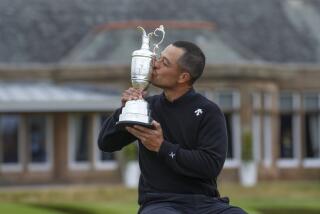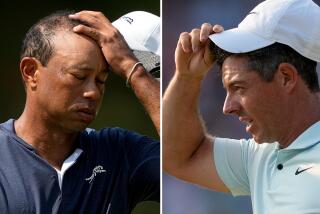Duel at Turnberry was as good as it gets
- Share via
Even as he approaches his 60th birthday, Tom Watson rarely looks back. He is more interested in competing than relishing memories of his eight major championships, including his most famous victory of all at Turnberry in the 1977 British Open.
There was one time, however, when Watson couldn’t escape history.
He returned to Turnberry in 2003 for the Senior British Open, and the television monitors in the clubhouse had continuous replays of his epic battle against Jack Nicklaus, now known as the “Duel in the Sun.”
Watson would stop and say to himself, “Yeah, that was a pretty good shot,” or “How did Jack do that?”
“It’s a wonderful memory,” he said. “There’s not a question.”
::
Tiger Woods and Phil Mickelson played together in the final round of the Masters this year, a pairing that brought Augusta National to life when each of them made a run at the leaders until they ran out of birdies or holes on which to make them.
Just imagine if they had been tied for the lead, not seven shots behind.
Consider how much noise they could have made had each scored matching 65s in the third round to essentially eliminate the rest of the field. Or the hysteria that would have followed if they had continued to match shot for shot, birdie for birdie, until the final hour.
That was Turnberry in 1977.
“You saw two of the great players of that era going toe to toe with each other,” said Greg Norman, who was 22 that summer when he made his British Open debut and missed the cut.
The gallery often follows the last group down the fairway on the closing hole at golf’s oldest championship. For this occasion, they spilled into the fairways midway through the round.
“The crowd was just going everywhere,” Nicklaus said. “The ropes meant nothing, people meant nothing, we meant nothing. They were running down the fairways on every hole. They were supposed to be back behind the ropes, and we let it go for a while because we were basically . . . it was a match play event. And everybody was watching us.”
Nicklaus and Watson finally stopped play and told officials they would not continue until the crowd got under control.
Indeed, there was nothing else to see that day. The next closest competitor was 10 shots behind.
::
Nicklaus had already won 14 majors. He had outlasted rivalries with Arnold Palmer, Gary Player, Lee Trevino and Johnny Miller. The latest challenge, however, was his toughest. Nicklaus learned plenty about Watson earlier that year at Augusta National, when he made a back-nine charge and Watson never blinked, holing a 20-foot birdie putt at the 17th that sewed up a two-shot victory in the Masters.
“I think both Watson and Trevino played me better than anybody else,” Nicklaus said. “Both of them played me very well. And I got them a few times too. But I think Watson probably got me more than anybody. He got me in three majors that I finished second in.”
Watson had already won four times that year when he arrived at Turnberry, and he felt he was the man to beat.
“I was at the top of my game at that point, hitting basically on all cylinders,” Watson said. “Going into the tournament, I was in good form, and that was one of the few times in my career I really felt I had a great chance of winning the tournament. Sometimes there might be something a little bit off in your game, and that may give you a little bit of a question about, ‘Do I have everything in order to win?’
“That week was one of those weeks where I really felt confident about my chances of winning.”
::
Both opened with a 68, two shots behind John Schroeder. Both followed with a 70 and trailed Roger Maltbie by one shot going into the third round.
“I was paired with Hubert Green in the third round, and I didn’t play so hot,” said Maltbie, who had a 72 to fall six shots behind. “I just remember it being an uncharacteristically hot week. I’ve never seen people get so sunburned my whole life.”
He could not ignore the noise ahead of him, not with Nicklaus and Watson each shooting 65 to reduce everyone else to the B-Flight of this British Open.
To this day, there has never been a major with that kind of gap -- 10 shots -- from a duel at the top of the leaderboard to third place. The closest to it was the 1903 U.S. Open at Baltusrol, when Willie Anderson beat David Brown in a playoff, and Stewart Gardner was eight shots behind him. No one talks much about that major. Anderson shot 82 that day.
::
Maltbie was six shots behind going into the final round, but not for long. He skied to an 80, and the only consolation was hearing history in the making behind him. The 72-hole record was shattered by eight shots that day, but for those who thought Turnberry was a pushover, consider that only one other player broke par for the championship -- Green, at one-under 279.
Nicklaus had a one-shot lead coming down the stretch and appeared to have control until Watson, fearless with the putter, rapped in a 60-foot birdie from the edge of the 15th green. They were tied, and remained that way after pars on the 16th.
Then came the turning point, and a shocking miss for Nicklaus.
Watson reached the green in two on the par-five 17th, some 20 feet away. Asked if there was one shot he would like to have back, Nicklaus picked his four-iron to the 17th.
Watson winced when he missed his eagle putt. Nicklaus pursed his lips when he missed his birdie putt.
Watson was one shot ahead with one to play.
::
Watson hit iron off the tee to the 18th fairway. Nicklaus planned on hitting a one-iron, but he had to attack, and went with driver.
“If I would have hit it well, I would have put pressure on him to have to play a really good shot,” Nicklaus said. “But I hit it through the fairway and it went under the edge of a gorse bush.”
It might not have mattered. Watson hit a seven-iron that was pure when it left the club, and the roar of the gallery was all he needed to know it was close, about two feet from the cup. Watson bowed his head and raised both arms.
The tournament was over. Almost.
Nicklaus gouged an eight-iron out of the gorse bush and the rough, a stunning shot that somehow reached the green, some 40 feet from the hole. No one knew just how close Watson had hit his seven-iron, particularly the fans who stood behind Nicklaus and did their part to help him.
Only later did Nicklaus find out what they had done.
“It’s a Scottish custom for good luck where they throw coins,” he said. “They say there was a whole pile of coins under that bush where people walked by and had thrown them in there and wished me good luck. It was really neat.”
::
Woods has not watched much tape of the ’77 British Open, only the final few holes. Asked what he recalled, Woods smiled.
“I can’t believe Jack made the putt,” he said. “How about that?”
Nicklaus took his familiar crouch over the putt, sent it toward the hole and watched it die into the cup for one final birdie and a 66.
He finished at 269, the lowest score in British Open history, a record that lasted under a minute.
Watson then tapped in his birdie for a 65 and finished at 268.
The four rounds for Nicklaus: 70-68-65-66.
The four rounds for Watson: 70-68-65-65.
::
Nicklaus said Turnberry was the best major he ever played without winning. Even now, when asked what he remembers about the ’77 British Open and the historic duel with Watson, his answer is simply, “I lost.”
For Watson, the embrace he shared with Nicklaus on the 18th green was almost as memorable as the victory itself.
“Jack was the most gracious competitor I’ve ever seen in the throes of defeat,” Watson said. “I’ve never seen somebody be able to take defeat and give credit to the player, even though he’s hurting inside. And he did that. When we walked off the 18th green, he put his arm around me -- and he about broke my neck, he squeezed he so hard.
“He said, ‘Tom, I gave it my best shot, but it wasn’t good enough. Congratulations.’ ”
--
(BEGIN TEXT OF INFOBOX)
British Open
When: Thursday-July 19.
Course: Turnberry, Scotland, Ailsa Course. It originally was designed by 1883 British Open champion Willie Fernie. It did not host its first Open until 1977, and this will be only the fourth time the British Open is played there.
Length: 7,204 yards.
Par: 35-35 -- 70.
Last year: Padraig Harrington became the first European in more than a century to win back to back at the British Open. He shot a 32 on the back nine at Royal Birkdale to close with a one-under 69 and win by four shots over Ian Poulter. The serious challenge came from 53-year-old Greg Norman, who had a one-shot lead with nine holes to play. Norman, taking a break from his honeymoon with tennis great Chris Evert, shot a 77 in the final round and tied for third.
Last time at Turnberry: Nick Price finished birdie-eagle-par and closed with a four-under 66 to beat Jesper Parnevik by one shot. The signature shot for Price was a 50-foot eagle putt on the 17th. The signature moment for Parnevik was failing to look at the leaderboard. He thought he needed a birdie on the final hole and wound up making bogey.
Open champions at Turnberry: Tom Watson (1977), Greg Norman (1986), Nick Price (1994)
Streaking: Padraig Harrington is trying to become the first player to win three straight British Opens since Peter Thomson in 1954-56.
Key statistic: All three British Open champions at Turnberry are in the World Golf Hall of Fame.
Noteworthy: For the first time since 2004, Tiger Woods does not hold any of the major titles.
Quoteworthy: “The two I’ve won are probably two of the toughest courses on the links rotation. I don’t think it would be considered as tough as those two.” -- Padraig Harrington on Turnberry, coming off consecutive Open titles at Carnoustie and Royal Birkdale.
Television (all times PDT): Thursday-Friday, 4 a.m. to 4 p.m., TNT. Saturday, 4-6 a.m., TNT; 6-11:30 a.m., Ch. 7. July 19, 3-5 a.m., TNT; 5-10:30 a.m., Ch. 7.
-- Associated Press
More to Read
Go beyond the scoreboard
Get the latest on L.A.'s teams in the daily Sports Report newsletter.
You may occasionally receive promotional content from the Los Angeles Times.










